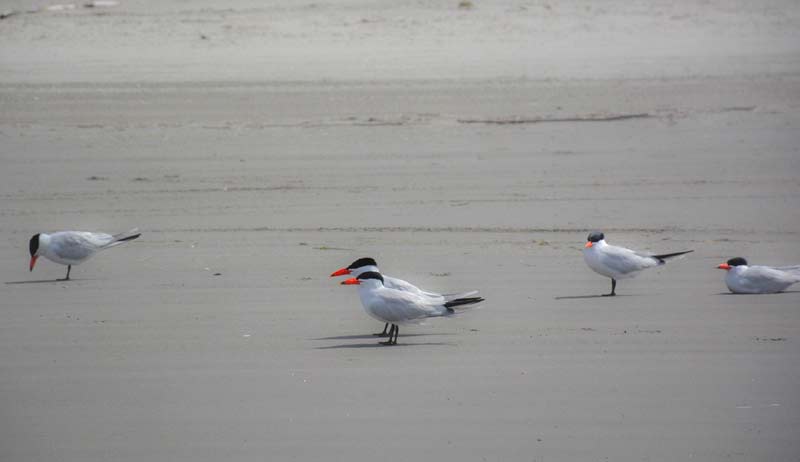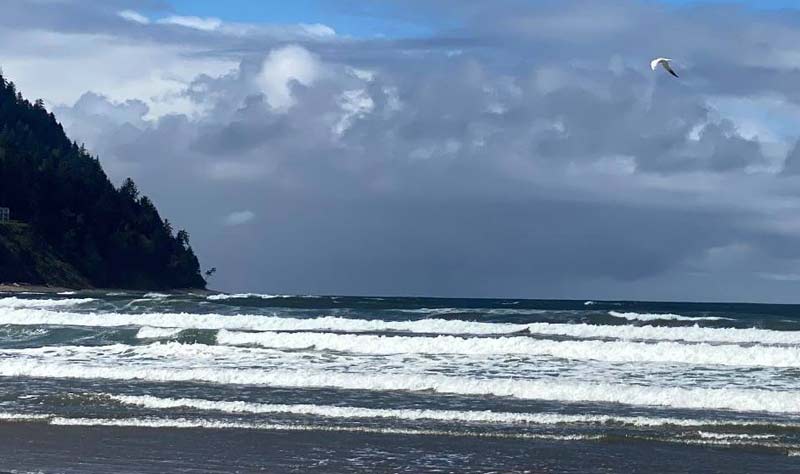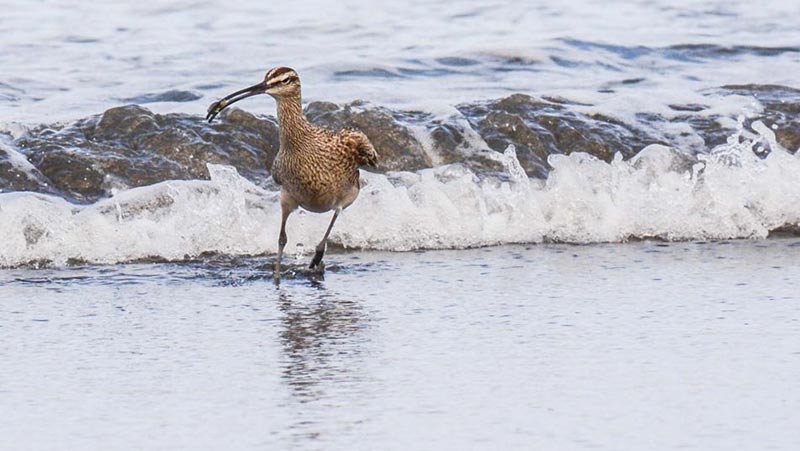Lovely Little Caspian Tern Returns to Oregon Coast
Published 04/27/21 at 8:35 PM PDT
By Oregon Coast Beach Connection staff

(Seaside, Oregon) – The medium-sized bird that makes a big, colorful impression has returned to the Oregon coast. Seaside Aquarium’s Tiffany Boothe exclaimed with glee Monday: “We saw our first Caspian tern today!” (Photos courtesy Seaside Aquarium / Tiffany Boothe)
Includes exclusive listings; some specials in winter
In Cannon Beach:
Includes rentals not listed anywhere else
In Manzanita, Wheeler, Rockaway Beach:
Some specials for winter
In Pacific City, Oceanside:
Some specials for winter
In Lincoln City:
Some specials for winter
In Depoe Bay, Gleneden Beach:
Some specials for winter
In Newport:
Look for some specials
In Waldport
Some specials for winter
In Yachats, Florence
Some specials for winter
Southern Oregon Coast Hotels / Lodgings
Reedsport to Brookings, places to stay; winter deals
It’s migration time for the white and black cuties, who generally reside a ways east of the beaches. The Caspian tern (Hydroprogne caspia) is fairly common on the shores of the Pacific Northwest but it’s still under some state and federal protections in terms of conservation planning.
“These birds are large as a gull, easily identifiable by their black-capped head and large orange bill and are common in bays and estuaries along the coast during spring and fall migrations,” Boothe said. “Smaller numbers of Caspian terns have even been found inland waters during migration including the mid-Columbia River, Willamette River, and Snake Rivers.”
Caspian terns are found along both coastlines of North America. They nest in sandy, flat areas of islands or waterways like bays, rivers or lakes, usually in colonies. Found from Alaska down through Mexico, their largest colony is right here in Oregon in the lower Columbia River Estuary, according to Boothe.
You can spot them along nearshore rivers, bays and beaches anywhere from Gold Beach, Coos Bay, Florence, Waldport to Warrenton and beyond.
“For the last two decades 12,000- 20,000 Caspian terns have taken season residence on East Sand Island in the Columbia River which represents 50-65% of the Caspian tern breeding populations within the Pacific Flyway corridor,” Boothe said.

Photo courtesy U.S. Army Corps of Engineers
When on Oregon coast beaches you’ll often see them catching flight as they prepare to dine. Boothe said when they feed on smaller fish they fly over the water, hover for a bit, and then suddenly plunge downward to snag their prey at the waters surface.
“They have been known to steal fish or eggs from other birds for food,” Boothe said.
Breeding colonies have tended to be farther east, beyond the Cascades. These are found along the Columbia River, lakes in southeast Oregon, and Summer Lake in south central Oregon, among other places.
Oregon Department of Fish and Wildlife (ODFW) said most of the colonies in Oregon have a history of intermittent use.
“Once they reach reproductive maturity at five years, mating pairs incubate one to three pale brown/black spotted eggs for approximately twenty two days,” Boothe said. “Young terns stay with parents up to eight months and as a species are able to live past 20 years.”
Also found on the beaches of the Oregon coast these days are whimbrels, Boothe said.
“They are currently taking a break from their migration to feed on the plethora of mole crabs inhabiting our shores,” she said. “Watch them as they probe the sand with their long thin beaks searching out their next meal.”
Oregon Coast Hotels for this event - South Coast Hotels - Where to eat - Maps - Virtual Tours
Cannon Beach Lodging
Nehalem Bay Lodgings
Manzanita Hotels, Lodging
Three Capes Lodging
Pacific City Hotels, Lodging
Lincoln City Lodging
Depoe Bay Lodging
Newport Lodging
Waldport Lodging
Yachats Lodging
Oregon Coast Vacation Rentals
Oregon Coast Lodging Specials


Below: the whimbrel, Seaside Aquarium

More About Oregon Coast hotels, lodging.....
More About Oregon Coast Restaurants, Dining.....
LATEST Related Oregon Coast Articles
Through 2 a.m. likely best, but some lights possible through dawn June 1 - 2. Space weather, astronomy
Rare Sperm Whale Stranding on N. Oregon Coast, Was Hit by Boat
Showing up near Gearhart, it will decompose naturally. Marine sciences
Coast Guard Barque 'America's Tall Ship' Coming to Portland Rose Fest, N. Ore...
Portland events: June 5 - 8; Astoria events June 13 - 15. Weather
Bright and Active Arietids Meteors May Hit Pre-Dawn Hours of Oregon, Washingt...
Look to east hour before sunrise and you may catch a show. Sciences, astronomy, weather
Why Now Could Be a Great Week for Spotting Killer Whales on Oregon Coast - Video
A good dozen documentations around Depoe Bay, Newport, Coos Bay, Bandon, Tillamook. Marine sciences
Summer Road Work, Traffic Issues Along Oregon Coast Include Astoria, Garibald...
Some daylight closures include bridges, OR 22, OR 18, OR 26, more. Travel tips. Seaside, Cannon Beach, Lincoln City. Travel tips
Pacific City Oregon Weather, 7-Day Forecasts, Live Conditions, Radar, Webcams...
Updated Constantly: Pacific City, Tierra Del Mar, Oregon Weather, Cams, Buoy Observations, Tides, Warnings - Alerts
Oregon Coast Has World's Oldest Harbor Seal, Celebrating 50 Years Soon
June 3 at Oregon Coast Aquarium in Newport. Newport events
Back to Oregon Coast
Contact Advertise on BeachConnection.net
All Content, unless otherwise attributed, copyright BeachConnection.net Unauthorized use or publication is not permitted























































